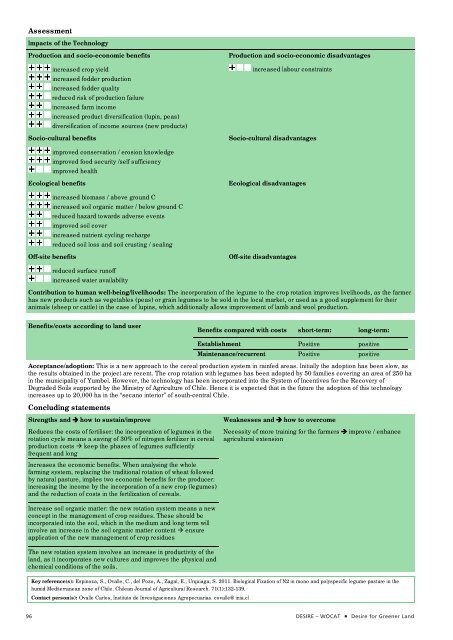Desire for Greener Land
Desire for Greener Land
Desire for Greener Land
You also want an ePaper? Increase the reach of your titles
YUMPU automatically turns print PDFs into web optimized ePapers that Google loves.
Assessment<br />
Impacts of the Technology<br />
Production and socio-economic benefits Production and socio-economic disadvantages<br />
increased crop yield<br />
increased fodder production<br />
increased fodder quality<br />
reduced risk of production failure<br />
increased farm income<br />
increased product diversification (lupin, peas)<br />
diversification of income sources (new products)<br />
increased labour constraints<br />
Socio-cultural benefits Socio-cultural disadvantages<br />
improved conservation / erosion knowledge<br />
improved food security /self sufficiency<br />
improved health<br />
Ecological benefits Ecological disadvantages<br />
increased biomass / above ground C<br />
increased soil organic matter / below ground C<br />
reduced hazard towards adverse events<br />
improved soil cover<br />
increased nutrient cycling recharge<br />
reduced soil loss and soil crusting / sealing<br />
Off-site benefits Off-site disadvantages<br />
reduced surface runoff<br />
increased water availability<br />
Contribution to human well-being/livelihoods: The incorporation of the legume to the crop rotation improves livelihoods, as the farmer<br />
has new products such as vegetables (peas) or grain legumes to be sold in the local market, or used as a good supplement <strong>for</strong> their<br />
animals (sheep or cattle) in the case of lupins, which additionally allows improvement of lamb and wool production.<br />
Benefits/costs according to land user<br />
Benefits compared with costs short-term: long-term:<br />
Establishment Positive positive<br />
Maintenance/recurrent Positive positive<br />
Acceptance/adoption: This is a new approach to the cereal production system in rainfed areas. Initially the adoption has been slow, as<br />
the results obtained in the project are recent. The crop rotation with legumes has been adopted by 50 families covering an area of 250 ha<br />
in the municipality of Yumbel. However, the technology has been incorporated into the System of Incentives <strong>for</strong> the Recovery of<br />
Degraded Soils supported by the Ministry of Agriculture of Chile. Hence it is expected that in the future the adoption of this technology<br />
increases up to 20,000 ha in the “secano interior” of south-central Chile.<br />
Concluding statements<br />
Strengths and how to sustain/improve Weaknesses and how to overcome<br />
Reduces the costs of fertiliser: the incorporation of legumes in the<br />
rotation cycle means a saving of 30% of nitrogen fertilizer in cereal<br />
production costs keep the phases of legumes sufficiently<br />
frequent and long<br />
Increases the economic benefits. When analysing the whole<br />
farming system, replacing the traditional rotation of wheat followed<br />
by natural pasture, implies two economic benefits <strong>for</strong> the producer:<br />
increasing the income by the incorporation of a new crop (legumes)<br />
and the reduction of costs in the fertilization of cereals.<br />
Increase soil organic matter: the new rotation system means a new<br />
concept in the management of crop residues. These should be<br />
incorporated into the soil, which in the medium and long term will<br />
involve an increase in the soil organic matter content ensure<br />
application of the new management of crop residues<br />
The new rotation system involves an increase in productivity of the<br />
land, as it incorporates new cultures and improves the physical and<br />
chemical conditions of the soils.<br />
Necessity of more training <strong>for</strong> the farmers improve / enhance<br />
agricultural extension<br />
Key reference(s): Espinoza, S., Ovalle, C., del Pozo, A., Zagal, E., Urquiaga, S. 2011. Biological Fixation of N2 in mono and polyspecific legume pasture in the<br />
humid Mediterranean zone of Chile. Chilean Journal of Agricultural Research. 71(1):132-139.<br />
Contact person(s): Ovalle Carlos, Instituto de Investigaciones Agropecuarias. covalle@inia.cl<br />
96 DESIRE – WOCAT <strong>Desire</strong> <strong>for</strong> <strong>Greener</strong> <strong>Land</strong>









